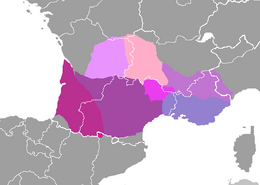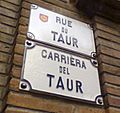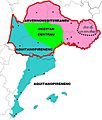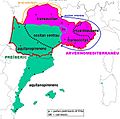Occitan language facts for kids
Quick facts for kids Occitan |
||||
|---|---|---|---|---|
| occitan, lenga d'òc, provençal | ||||
| Native to | France, Spain, Italy, Monaco | |||
| Native speakers | estimates range from 100,000 to 800,000 (2007–2012) | |||
| Language family | ||||
| Early forms: |
Old Occitan
|
|||
| Dialects |
Auvergnat
Gascon (including Aranese dialect)
Languedocien
Limousin
Provençal
Vivaro-Alpine
|
|||
| Official status | ||||
| Official language in | Catalonia (Spain) | |||
| Recognised minority language in | France Italy (Law number 482 of 15 December 1999) |
|||
| Regulated by | Conselh de la Lenga Occitana; Congrès Permanent de la Lenga Occitana; Institut d'Estudis Aranesi | |||
| Linguasphere | 51-AAA-g & 51-AAA-f | |||
 |
||||

various dialects of Occitan
|
||||
|
||||
Occitan is a fascinating language, also called lenga d'òc by the people who speak it. It's a Romance language, which means it comes from Latin, just like French, Spanish, and Italian. You can hear Occitan spoken in the south of France, in some parts of Italy (called the Occitan Valleys), in the Val d'Aran region of Catalonia in Spain, and in Monaco. These areas are sometimes unofficially known as Occitania.
Occitan is special because it developed differently from the official languages in these countries. It gets its name, lenga d'òc (which means "language of oc"), from its word for yes, which is òc. This is different from oui in French or sì in Italian. This unique word for "yes" helps us classify it among other Romance languages.
Exploring Occitan Dialects
Just like many languages, Occitan has different ways of being spoken, called dialects. These are like different versions of the same language.
Here are some of the main dialects of Occitan:
- Alpine (also known as Vivaro-Alpine or Provençal Alpine)
- Auvergnat
- Gascon (this includes Aranese, which is spoken in the Val d'Aran in Catalonia, Spain)
- Languedocien
- Limousin
- Provençal
It's interesting to know that some of these names, like Provençal, Limousin, and Gascon, were once used to refer to the entire Occitan language!
Images for kids
-
This bilingual street sign in Toulouse shows both Occitan and French. Many signs like this are kept for their historical charm.
-
A sign in Aranese, a dialect of Occitan, in Bossòst, Val d'Aran, Spain.
-
This map shows Occitan dialects as classified by Pierre Bec.
-
A statue in Lourdes, France. It shows a phrase in Gascon, an Occitan dialect, said by the Virgin Mary to Bernadette Soubirous.
See also
 In Spanish: Idioma occitano para niños
In Spanish: Idioma occitano para niños









